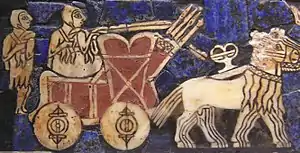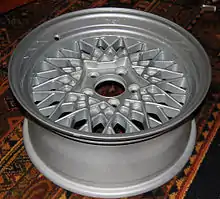Wheel
In its primitive form, a wheel is a circular block of a hard and durable material at whose center has been bored a hole through which is placed an axle bearing about which the wheel rotates when torque is applied to the wheel about its axis. The wheel and axle assembly can be considered one of the six simple machines. When placed vertically under a load-bearing platform or case, the wheel turning on the horizontal axle makes it possible to transport heavy loads. This arrangement is the main topic of this article, but there are many other applications of a wheel addressed in the corresponding articles: when placed horizontally, the wheel turning on its vertical axle provides the spinning motion used to shape materials (e.g. a potter's wheel); when mounted on a column connected to a rudder or to the steering mechanism of a wheeled vehicle, it can be used to control the direction of a vessel or vehicle (e.g. a ship's wheel or steering wheel); when connected to a crank or engine, a wheel can store, release, or transmit energy (e.g. the flywheel). A wheel and axle with force applied to create torque at one radius can translate this to a different force at a different radius, also with a different linear velocity.
.jpg.webp)
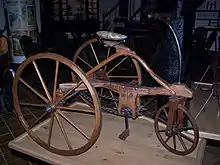
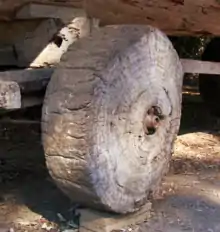
Etymology
The English word wheel comes from the Old English word hweol, hweogol, from Proto-Germanic *hwehwlan, *hwegwlan, from Proto-Indo-European *kwekwlo-,[1] an extended form of the root *kwel- "to revolve, move around". Cognates within Indo-European include Icelandic hjól "wheel, tyre", Greek κύκλος kúklos, and Sanskrit chakra, the latter two both meaning "circle" or "wheel".[2]
History
The place and time of an "invention" of the wheel remains unclear, because the oldest hints do not guarantee the existence of real wheeled transport, or are dated with too much scatter.[3] Mesopotamian civilization is credited with the invention of the wheel.[4][5][6] The invention of the solid wooden disk wheel falls into the late Neolithic, and may be seen in conjunction with other technological advances that gave rise to the early Bronze Age. This implies the passage of several wheel-less millennia even after the invention of agriculture and of pottery, during the Aceramic Neolithic.
- 4500–3300 BC (Copper Age): invention of the potter's wheel; earliest solid wooden wheels (disks with a hole for the axle); earliest wheeled vehicles; domestication of the horse
- 3300–2200 BC (Early Bronze Age)
- 2200–1550 BC (Middle Bronze Age): invention of the spoked wheel and the chariot
The Halaf culture of 6500–5100 BC is sometimes credited with the earliest depiction of a wheeled vehicle, but this is doubtful as there is no evidence of Halafians using either wheeled vehicles or even pottery wheels.[7] Precursors of wheels, known as "tournettes" or "slow wheels", were known in the Middle East by the 5th millennium BC. One of the earliest examples was discovered at Tepe Pardis, Iran, and dated to 5200–4700 BC. These were made of stone or clay and secured to the ground with a peg in the center, but required significant effort to turn. True potter's wheels, which are freely-spinning and have a wheel and axle mechanism, were developed in Mesopotamia (Iraq) by 4200–4000 BC.[8] The oldest surviving example, which was found in Ur (modern day Iraq), dates to approximately 3100 BC.[9] Wheel has been also found in the Indus Valley Civilization, a 4th millennium BCE civilization covering areas of present-day India and Pakistan.[10]
The oldest indirect evidence of wheeled movement was found in the form of miniature clay wheels north of the Black Sea before 4000 B.C. From the middle of the 4th millennium BC onward, the evidence is condensed throughout Europe in the form of toy cars, depictions, or ruts.[11] In Mesopotamia, depictions of wheeled wagons found on clay tablet pictographs at the Eanna district of Uruk, in the Sumerian civilization are dated to c. 3500–3350 BC.[12] In the second half of the 4th millennium BC, evidence of wheeled vehicles appeared near-simultaneously in the Northern (Maykop culture) and South Caucasus and Eastern Europe (Cucuteni-Trypillian culture). Depictions of a wheeled vehicle appeared between 3631 and 3380 BC in the Bronocice clay pot excavated in a Funnelbeaker culture settlement in southern Poland.[13] In nearby Olszanica, a 2.2 m wide door was constructed for wagon entry; this barn was 40 m long with 3 doors, dated to 5000 B.C - 7000 years old, and belonged to neolithic Linear Pottery culture.[14] Surviving evidence of a wheel-axle combination, from Stare Gmajne near Ljubljana in Slovenia (Ljubljana Marshes Wooden Wheel), is dated within two standard deviations to 3340–3030 BC, the axle to 3360–3045 BC.[15] Two types of early Neolithic European wheel and axle are known; a circumalpine type of wagon construction (the wheel and axle rotate together, as in Ljubljana Marshes Wheel), and that of the Baden culture in Hungary (axle does not rotate). They both are dated to c. 3200–3000 BC.[16] Some historians believe that there was a diffusion of the wheeled vehicle from the Near East to Europe around the mid-4th millennium BC.[17]
.jpg.webp)
Early wheels were simple wooden disks with a hole for the axle. Some of the earliest wheels were made from horizontal slices of tree trunks. Because of the uneven structure of wood, a wheel made from a horizontal slice of a tree trunk will tend to be inferior to one made from rounded pieces of longitudinal boards.
The spoked wheel was invented more recently and allowed the construction of lighter and swifter vehicles. The earliest known examples of wooden spoked wheels are in the context of the Sintashta culture, dating to c. 2000 BC (Krivoye Lake). Soon after this, horse cultures of the Caucasus region used horse-drawn spoked-wheel war chariots for the greater part of three centuries. They moved deep into the Greek peninsula where they joined with the existing Mediterranean peoples to give rise, eventually, to classical Greece after the breaking of Minoan dominance and consolidations led by pre-classical Sparta and Athens. Celtic chariots introduced an iron rim around the wheel in the 1st millennium BC.
In China, wheel tracks dating to around 2200 BC have been found at Pingliangtai, a site of the Longshan Culture.[18] Similar tracks were also found at Yanshi, a city of the Erlitou culture, dating to around 1700 BC. The earliest evidence of spoked wheels in China comes from Qinghai, in the form of two wheel hubs from a site dated between 2000 and 1500 BC.[19]
In Britain, a large wooden wheel, measuring about 1 m (3.3 ft) in diameter, was uncovered at the Must Farm site in East Anglia in 2016. The specimen, dating from 1,100 to 800 BC, represents the most complete and earliest of its type found in Britain. The wheel's hub is also present. A horse's spine found nearby suggests the wheel may have been part of a horse-drawn cart. The wheel was found in a settlement built on stilts over wetland, indicating that the settlement had some sort of link to dry land.[20]

Although large-scale use of wheels did not occur in the Americas prior to European contact, numerous small wheeled artifacts, identified as children's toys, have been found in Mexican archeological sites, some dating to approximately 1500 BC.[21] It is thought that the primary obstacle to large-scale development of the wheel in the Americas was the absence of domesticated large animals that could be used to pull wheeled carriages.[22] The closest relative of cattle present in Americas in pre-Columbian times, the American bison, is difficult to domesticate and was never domesticated by Native Americans; several horse species existed until about 12,000 years ago, but ultimately became extinct.[23] The only large animal that was domesticated in the Western hemisphere, the llama, a pack animal, but not physically suited to use as a draft animal to pull wheeled vehicles,[24] and use of the llama did not spread far beyond the Andes by the time of the arrival of Europeans.
Nubians from after about 400 BC used wheels for spinning pottery and as water wheels.[25] It is thought that Nubian waterwheels may have been ox-driven.[26] It is also known that Nubians used horse-drawn chariots imported from Egypt.[27]
The wheel was barely used, with the exception of Ethiopia, in Sub-Saharan Africa well into the 19th century, but this changed with the arrival of the Europeans.[28][29]
The spoked wheel was in continued use without major modification until the 1870s, when wire-spoked wheels and pneumatic tires were invented.[30] Pneumatic tires can greatly reduce rolling resistance and improve comfort. Wire spokes are under tension, not compression, making it possible for the wheel to be both stiff and light. Early radially-spoked wire wheels gave rise to tangentially-spoked wire wheels, which were widely used on cars into the late 20th century. Cast alloy wheels are now more commonly used; forged alloy wheels are used when weight is critical.
The invention of the wheel has also been important for technology in general, important applications including the water wheel, the cogwheel (see also antikythera mechanism), the spinning wheel, and the astrolabe or torquetum. More modern descendants of the wheel include the propeller, the jet engine, the flywheel (gyroscope) and the turbine.
.jpg.webp) Ljubljana Marshes Wheel, from around 3150 BC (restored model of the oldest exactly radiocarbon dated wooden wheel part in the world).
Ljubljana Marshes Wheel, from around 3150 BC (restored model of the oldest exactly radiocarbon dated wooden wheel part in the world). Twentieth-century solid wheel made of wooden boards, bound with a metal wheel rim
Twentieth-century solid wheel made of wooden boards, bound with a metal wheel rim
 Spoked wheel with bronze sheeting from Árokalja, from around 1000 BC.
Spoked wheel with bronze sheeting from Árokalja, from around 1000 BC.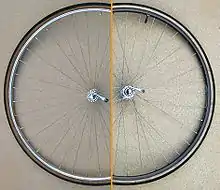
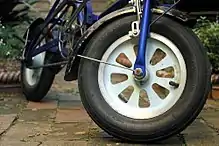
Mechanics and function
A wheeled vehicle requires much less work to move than simply dragging the same weight. The low resistance to motion is explained by the fact that the frictional work done is no longer at the surface that the vehicle is traversing, but in the bearings. In the simplest and oldest case the bearing is just a round hole through which the axle passes (a "plain bearing"). Even with a plain bearing, the frictional work is greatly reduced because:
- The normal force at the sliding interface is same as with simple dragging.
- The sliding distance is reduced for a given distance of travel.
- The coefficient of friction at the interface is usually lower.
Example:
- If a 100 kg object is dragged for 10 m along a surface with the coefficient of friction μ = 0.5, the normal force is 981 N and the work done (required energy) is (work=force x distance) 981 × 0.5 × 10 = 4905 joules.
- Now give the object 4 wheels. The normal force between the 4 wheels and axles is the same (in total) 981 N. Assume, for wood, μ = 0.25, and say the wheel diameter is 1000 mm and axle diameter is 50 mm. So while the object still moves 10 m the sliding frictional surfaces only slide over each other a distance of 0.5 m. The work done is 981 × 0.25 × 0.5 = 123 joules; the work done has reduced to 1/40 of that of dragging.
Additional energy is lost from the wheel-to-road interface. This is termed rolling resistance which is predominantly a deformation loss. It depends on the nature of the ground, of the material of the wheel, its inflation in the case of a tire, the net torque exerted by the eventual engine, and many other factors.
A wheel can also offer advantages in traversing irregular surfaces if the wheel radius is sufficiently large compared to the irregularities.
The wheel alone is not a machine, but when attached to an axle in conjunction with bearing, it forms the wheel and axle, one of the simple machines. A driven wheel is an example of a wheel and axle. Wheels pre-date driven wheels by about 6000 years, themselves an evolution of using round logs as rollers to move a heavy load—a practice going back in pre-history so far that it has not been dated.
Construction
Rim
The rim is the "outer edge of a wheel, holding the tire."[31] It makes up the outer circular design of the wheel on which the inside edge of the tire is mounted on vehicles such as automobiles. For example, on a bicycle wheel the rim is a large hoop attached to the outer ends of the spokes of the wheel that holds the tire and tube.
In the 1st millennium BC an iron rim was introduced around the wooden wheels of chariots.
Hub
The hub is the center of the wheel, and typically houses a bearing, and is where the spokes meet.
A hubless wheel (also known as a rim-rider or centerless wheel) is a type of wheel with no center hub. More specifically, the hub is actually almost as big as the wheel itself. The axle is hollow, following the wheel at very close tolerances.
Spokes
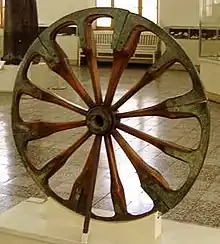
A spoke is one of some number of rods radiating from the center of a wheel (the hub where the axle connects), connecting the hub with the round traction surface. The term originally referred to portions of a log which had been split lengthwise into four or six sections. The radial members of a wagon wheel were made by carving a spoke (from a log) into their finished shape. A spokeshave is a tool originally developed for this purpose. Eventually, the term spoke was more commonly applied to the finished product of the wheelwright's work, than to the materials used.
Wire
The rims of wire wheels (or "wire spoked wheels") are connected to their hubs by wire spokes. Although these wires are generally stiffer than a typical wire rope, they function mechanically the same as tensioned flexible wires, keeping the rim true while supporting applied loads.
Wire wheels are used on most bicycles and still used on many motorcycles. They were invented by aeronautical engineer George Cayley and first used in bicycles by James Starley. A process of assembling wire wheels is described as wheelbuilding.
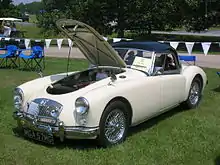
Tire/Tyre
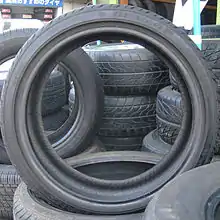
A tire (in American English and Canadian English) or tyre (in some Commonwealth Nations such as UK, India, South Africa, Australia and New Zealand) is a ring-shaped covering that fits around a wheel rim to protect it and enable better vehicle performance by providing a flexible cushion that absorbs shock while keeping the wheel in close contact with the ground. The word itself may be derived from the word "tie," which refers to the outer steel ring part of a wooden cart wheel that ties the wood segments together (see Etymology below).
The fundamental materials of modern tires are synthetic rubber, natural rubber, fabric and wire, along with other compound chemicals. They consist of a tread and a body. The tread provides traction while the body ensures support. Before rubber was invented, the first versions of tires were simply bands of metal that fitted around wooden wheels to prevent wear and tear. Today, the vast majority of tires are pneumatic inflatable structures, comprising a doughnut-shaped body of cords and wires encased in rubber and generally filled with compressed air to form an inflatable cushion. Pneumatic tires are used on many types of vehicles, such as cars, bicycles, motorcycles, trucks, earthmovers, and aircraft.
Protruding or covering attachments
Extreme off-road conditions have resulted in the invention of several types of wheel covers, which may be constructed as removable attachments, or as permanent covers. Wheels like this are nolonger necessarily round, or have panels that make the ground contact area flat.
Examples:
- Chains can be used to cover the tire. They are used in deep snow.[32]
- Dreadnaught wheel - A type of permanently attached hinged panels for general extreme off-road use. These are not connected directly to the wheels, but the eachother.
- Pedrail wheel - A system of rails that holds panels that hold the vehicle. These do not necessarily have to be built as a circle (wheel) and are thus also a form of Continuous track.
- A version of the above examples (name unknown to the writer) was commonly used on heavy artillery during World War I. Specific examples: Cannone da 149/35 A and the Big Bertha. These were panels that were connected to eachother by multiple hinges and could be installed over a contemporary wheel.
- Continuous track - A system of linked and hinged chains/panels that cover multiple wheels in a way that allows the vehicles mass to be distributed across the space between wheels that are positioned in front of / behind other wheels.
- "Tire totes" - A bag designed to cover a tire to improve traction in deep snow.[33] [34]
Alternatives
While wheels are very widely used for ground transport, there are alternatives, some of which are suitable for terrain where wheels are ineffective. Alternative methods for ground transport without wheels include:
- Maglev
- Sled or travois
- Hovercraft
- A walking machine
- Caterpillar tracks (operated by wheels)
- Pedrail wheels, using aspects of both wheel and caterpillar track
- Spheres, as used by Dyson vacuum cleaners and hamster balls
- Screw-propelled vehicle
Symbolism
The wheel has also become a strong cultural and spiritual metaphor for a cycle or regular repetition (see chakra, reincarnation, Yin and Yang among others). As such and because of the difficult terrain, wheeled vehicles were forbidden in old Tibet. The wheel in ancient China is seen as a symbol of health and strength and utilized by some villages as a tool to predict future health and success. The diameter of the wheel is indicator of one's future health.
The winged wheel is a symbol of progress, seen in many contexts including the coat of arms of Panama, the logo of the Ohio State Highway Patrol and the State Railway of Thailand. The wheel is also the prominent figure on the flag of India. The wheel in this case represents law (dharma). It also appears in the flag of the Romani people, hinting to their nomadic history and their Indian origins.
The introduction of spoked (chariot) wheels in the Middle Bronze Age appears to have carried somewhat of a prestige. The sun cross appears to have a significance in Bronze Age religion, replacing the earlier concept of a Solar barge with the more 'modern' and technologically advanced solar chariot. The wheel was also a solar symbol for the Ancient Egyptians.[35]
See also
- Types: Alloy wheel, Artillery wheel, Ball transfer unit, Bicycle wheel, Caster, Cogwheel, Dreadnaught wheel, Driving wheel, Flywheel, Hubless wheel, Inline skate wheel, Mansell wheel, Mecanum wheel, Motorcycle wheel, Omni wheel, Pedrail wheel, Pressed Steel wheel, Skateboard wheel, Square wheel, Stairclimber wheel, Steering wheel (Ship's wheel), Train wheel, Tweel, Wagon wheel, Wire wheel
- Components: Axle, Bogie, Differential, Drive shaft, Drivetrain, Rim, Snow chains, Spoke, Tire, Wheelset (rail transport)
- Related technologies and concepts: Archimedes screw, Breaking wheel, Color wheel, Compact disc, Ferris wheel, Pottery wheel, Propeller, Reinventing the wheel, Spindle whorl, Trackball, Wagon-wheel effect, Water wheel, Wheelbarrow, Wheelie, Wheel of Fortune, Windlass, Windmill
- Alternatives: Air cushion, Continuous track, Counter-rotating screws, Leg mechanism, Magnetic levitation, Wing-in-ground-effect
- History: The Horse, The Wheel and Language, Rotating locomotion in living systems, Terrestrial locomotion in animals: Rolling, Robot locomotion
- Theory: Rolling resistance, Rotational energy, Torque, Wheel and axle (simple machine), Wheel sizing
References
- "wheel". Online Etymology Dictionary. Archived from the original on 3 July 2017. Retrieved 28 March 2007.
- "American Heritage Dictionary Entry: wheel". Houghton Mifflin Harcourt Publishing Company. Archived from the original on 20 July 2013. Retrieved 26 November 2012.
- Holm, Hans J. J. G.: The Earliest Wheel Finds, their Archeology and Indo-European Terminology in Time and Space, and Early Migrations around the Caucasus. Series Minor 43. ARCHAEOLINGUA ALAPÍTVÁNY, Budapest, 2019. ISBN 978-615-5766-30-5.
- Transportation. BPI. p. 4. ISBN 9788184972436.
- Mitchell Lewis Ditkoff (May 2008). Awake at the Wheel: Getting Your Great Ideas Rolling (in an Uphill World). Morgan James Publishing. p. 15. ISBN 9781600377709.
- Y C Chiu (2010). An Introduction to the History of Project Management: From the Earliest Times to A.D. 1900. Eburon. p. 24. ISBN 9789059724372.
- V. Gordon Childe (1928). New Light on the Most Ancient East. p. 110.
- D.T. Potts (2012). A Companion to the Archaeology of the Ancient Near East. p. 285.
- Moorey, Peter Roger Stuart (1999) [1994]. Ancient Mesopotamian Materials and Industries: The Archaeological Evidence. Winona Lake, IN: Eisenbrauns. p. 146. ISBN 978-1-57506-042-2. Archived from the original on 17 October 2017. Retrieved 26 October 2017.
- John Marshall (1996). Mohenjo-Daro and the Indus Civilization: Being an Official Account of Archaeological Excavations at Mohenjo-Daro Carried Out by the Government of India Between the Years 1922 and 1927, Volume 1. Asian Education Services. p. 554. ISBN 9788120611795.
- Hans J.J.G. Holm: The Earliest Wheel Finds, Their Archeology and Indo-European Terminology in Time and Space, and Early Migrations around the Caucasus. Archaeolingua Alapítvány, Budapest, 2019, ISBN 978-963-9911-34-5
- Attema, P. A. J.; Los-Weijns, Ma; Pers, N. D. Maring-Van der (December 2006). "Bronocice, Flintbek, Uruk, Jebel Aruda and Arslantepe: The Earliest Evidence of Wheeled Vehicles in Europe and the Near East". Palaeohistoria. University of Groningen. 47/48: 10–28 (11). ISBN 9789077922187. Archived from the original on 22 August 2020. Retrieved 1 May 2019.
- Anthony, David A. (2007). The horse, the wheel, and language: how Bronze-Age riders from the Eurasian steppes shaped the modern world. Princeton, NJ: Princeton University Press. p. 67. ISBN 978-0-691-05887-0.
- "35. Olszanica Longhouse 6: Why has it got wide doors?". 26 October 2018.
- Velušček, A.; Čufar, K. and Zupančič, M. (2009) "Prazgodovinsko leseno kolo z osjo s kolišča Stare gmajne na Ljubljanskem barju", pp. 197–222 in A. Velušček (ed.). Koliščarska naselbina Stare gmajne in njen as. Ljubljansko barje v 2. polovici 4. tisočletja pr. Kr. Opera Instituti Archaeologici Sloveniae 16. Ljubljana.
- Fowler, Chris; Harding, Jan and Hofmann, Daniela (eds.) (2015). The Oxford Handbook of Neolithic Europe. Archived 29 December 2016 at the Wayback Machine OUP Oxford. ISBN 0-19-166688-2. p. 109.
- Attema, P. A. J.; Los-Weijns, Ma; Maring-Van der Pers, N. D. (December 2006). "Bronocice, Flintbek, Uruk, Jebel Aruda and Arslantepe: The Earliest Evidence of Wheeled Vehicles in Europe and the Near East". Palaeohistoria. University of Groningen. 47/48: 10-28 (19-20). ISBN 9789077922187. Archived from the original on 22 August 2020. Retrieved 1 May 2019.
- "Central China discovers earliest wheel ruts". Xinhua. Archived from the original on 22 August 2020. Retrieved 20 January 2020.
- Barbieri-Low, Anthony (February 2000) "Wheeled Vehicles in the Chinese Bronze Age (c. 2000–741 B.C.)", p. 11-12. Sino-Platonic Papers
- "Bronze Age wheel at 'British Pompeii' Must Farm an 'unprecedented find'". BBC. Archived from the original on 9 November 2018. Retrieved 18 February 2016.
- Ekholm, Gordon F (April 1946). "Wheeled Toys in Mexico". American Antiquity. 11 (4): 222–28. doi:10.2307/275722. JSTOR 275722.
- Diamond, Jared (1999). Guns, Germs, and Steel: The Fates of Human Societies. New York: Norton. p. 237. ISBN 978-0-393-31755-8. Archived from the original on 26 March 2020. Retrieved 9 November 2019.
- Singer, Ben (May 2005). A brief history of the horse in America. Canadian Geographic Magazine. Archived from the original on 19 August 2014.
- Thomas Ryder (1986). The Carriage Journal: Vol 23 No 4 Spring 1986. Carriage Assoc. of America. p. 209.
- "Crafts – Uncovering Treasures of Ancient Nubia". NYTimes.com. 27 February 1994. Archived from the original on 22 August 2020. Retrieved 18 September 2017.
- "What the Nubians Ate". Discover Magazine. Archived from the original on 1 March 2009. Retrieved 5 February 2009.
- Fage, J.D.; Oliver, Roland Anthony (1975). The Cambridge History of Africa. Cambridge University Press. p. 278. ISBN 978-0-521-21592-3. Archived from the original on 10 June 2020. Retrieved 22 February 2020.
- Chaves, Isaías; Engerman, Stanley L.; Robinson, James A. (2012). Reinventing the Wheel: The Economic Benefits of Wheeled Transportation in Early Colonial British West Africa (PDF). Weatherhead Center for International Affairs. p. 1. Archived from the original (PDF) on 6 January 2014. Retrieved 5 January 2014.
One of the great technological puzzles of Sub-Saharan African economic history is that wheeled transportation was barely used prior to the colonial period. Instead, head porterage was the main method of transportation.
- Law, Robin C. (1980). "Wheeled Transportation in Pre-Colonial West Africa". Africa. 50 (3): 249–62. doi:10.2307/1159117. JSTOR 1159117.
- bookrags.com Archived 27 May 2008 at the Wayback Machine – Wheel and axle
- Jewel, Elizabeth (2006). The Pocket Oxford Dictionary and Thesaurus. Oxford University Press. p. 722. ISBN 978-0-19-530715-3. Archived from the original on 4 May 2016. Retrieved 4 January 2012.
- Ecamples of snow chains
- Examples of "tire totes"
- Another example of "tire totes"
- Hall, Adelaide S. (2005). A Glossary of Important Symbols in Their Hebrew: Pagan and Christian Forms. p. 56. ISBN 978-1-59605-593-3. Archived from the original on 8 May 2016. Retrieved 17 October 2015.
External links
| Wikimedia Commons has media related to Wheels. |
| Wikimedia Commons has media related to Automobile wheels. |
| Look up wheel in Wiktionary, the free dictionary. |
